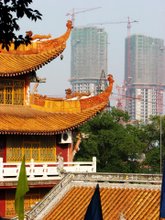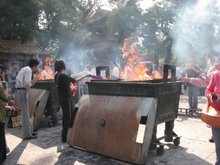This is an article I just wrote for Chengdoo Magazine, a slightly more formal 'zine' for the hipster ex-pats in my neighborhood.
Greening the Grey.
May 9th and 10th marked the 4th Forum on Chinese Green Cities hosted by the Chengdu municipal government, and attended by government officials from many Chinese provinces, international forestry academics, the UN Food and Agriculture Organization, and NGO representatives from Chengdu and abroad. The conference was designed to celebrate China’s “greenest” cities while addressing issues of sustainable development and the importance of urban green spaces. It also included an afternoon showcase of Chengdu’s many green spaces…although they may have appeared a bit more gray than expected on that ironically smoggy afternoon.
Since arriving in China, the word green has become synonymous with a vague sense of some “environmentally friendly” qualities. There are “green foods” in the supermarket, “green buildings”, “green lifestyles”, the clothing brand, “Nature” whose bright green sign clashes with almost everything inside, and now “green cities” popping up everywhere. But what exactly does “green” mean? In relation to green cities for example, are we literally talking about the number of leafy plants in side the second ring road?
Greenery is obviously important. Green areas and wildlife have measurable positive impacts not only on aesthetics, but also on local air, water, and environmental quality, as well as mental health. The right mix of species in an urban environment will serve multiple functions. Removing carbon from the atmosphere, emitting volatile organic compounds that reduce the formation of dangerous ozone and carbon monoxide, helping to control runoff, and stabilizing microclimates are just a few of their positive environmental effects. At the conference, one speaker from the University of Copenhagen also pointed out that in Denmark, proximity to green spaces is directly correlated to level of fitness, and that recovery of hospital patients with a view of greenery is significantly faster that recovery of those who view a brick. It’s these kinds of findings that have encouraged many Chinese cities to promote more proactive urban and rural tree-planting initiatives.
But “green” has to go deeper and address sustainability in a more holistic sense… or all the trees we plant will shrivel and die in a bone-dry city full of smog and acid rain. When we label something “green”, we also need to consider every kind of input and waste involved in its creation and day to day use. Clean, renewable, and efficient energy supply, effective and sustainable use of resources, comprehensive waste management, and implementation of the “3 Rs” reduce, reuse, and recycle are all concepts must go hand in hand with a “green” label. Where “green cities” are concerned, these concepts are beginning to prevail, with China host to the foremost global example of sustainable urban planning. Right off the Chinese mainland on Chongming island, where the world’s first sustainable “eco-city” is in its first phase of development. ARUP, a British consulting firm, and the Shanghai Industrial Investment Company (SIIC) are masterplanning the city, which, by 2010, will house 500,000 people, and provide the opportunity for people to lead an integrated and truly sustainable life. The island city will use recycled water, cogeneration and biomass energy sources, while remaining “as carbon neutral as possible”. Ecological sensitivity is a priority as the island that is mostly used for agricultural activity and is adjacent to a critical wetland, but sustainability has also been expanded to include social, cultural, and economic frameworks. It’s this type of comprehensive and innovative thinking that we should expect from everything green.
So, do not accept the nebulously green. When a product or event claims, “green!” require specifics: the basic whats, whys, and hows, or it’s a wash. It’s your role as consumers and as dwellers of whichever place you go to keep a critical eye on green, (and any other vague adjectives for that matter). If there is no one verifying that the eggs really are free range, organic, or bringing you and your friends to the farm in the back of the hybrid pick-up, you should assume that the chickens dyed their feathers last weekend at a party cause it’s so totally hip to be green right now. Or better, be conscious of the fact that although talk is perhaps the first step towards decisive commitments, right now there’s still a lot of grey in our greens.
Tuesday, May 15, 2007
Subscribe to:
Post Comments (Atom)




No comments:
Post a Comment